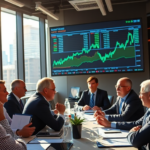Gold Not Immune to Equity Market Pullback, Gower Says
As the traditional safe haven asset, gold has long been a focus for investors during times of economic unpredictability. However, recent analysis indicates that gold may not be entirely insulated from fluctuations in equity markets. In the past year alone, gold prices have surged by over 60%, fueled by economic shifts and geopolitical tensions, yet experts caution that this rally might not be immune to future dips across financial markets.
Gold’s Recent Surge: A Closer Look
Gold’s remarkable rise has been partly attributed to a dovish pivot from the Federal Reserve, notably highlighted during the annual Jackson Hole symposium. Historically, gold is perceived as a stable investment in volatile times, and its upward trajectory aligns with similar trends among various asset classes. The metal’s inherent liquidity means it is often liquidated during market sell-offs, mirroring movements in silver, platinum, and palladium.
“Gold has seen significant volatility lately, and while its rally aligns with that of other asset classes, this also means it’s not entirely decoupled from overall market trends,” remarked financial analyst Jonathan Gower. This observation underpins the current conversation among investors about gold’s role in a diversified portfolio, especially as global dynamics continue to shift.
Diversification Drives and Geopolitical Influences
Geopolitical events, such as the ongoing war in Ukraine, have led central banks to reconsider their asset allocations, with significant diversification away from the US dollar in favor of gold. This move to bolster gold reserves reflects a broader strategy to safeguard against potential economic sanctions and vulnerabilities inherent in currency markets.
Dr. Elise Martinez, a geopolitical expert from the University of Texas, commented, “The Ukraine conflict has prompted nations to diversify their holdings, especially amid fears of economic penalties disrupting traditional markets. This diversification leans heavily on tangible assets like gold, seen as a form of financial security.”
Central Banks and ETFs: Shifting the Market Dynamics
During 2022 and 2023, central banks notably increased their gold purchases, though this trend seems to have stabilized in early 2024. Exchange-traded funds (ETFs), which had been sellers of gold for several years, have now become net buyers, driven largely by interest rate changes and anticipations of longer-term monetary policies from the Federal Reserve.
Andrew Kline, a local financial consultant, explained, “This shift from ETFs reflects a broader trend where financial products are aligning with central banks’ strategies, indicating a consolidation phase that counters several unpredictable years.”
Historical Parallels and Future Risks
While today’s gold rally shares similarities with previous surges, such as in 2020, historical patterns suggest that should equity markets pull back, gold might experience a corresponding decline. The interconnectedness of financial assets highlights the fragility within which these commodities operate.
“Investor sentiment has been buoyant, but it’s contingent on broader market performance. Should equities retract, gold’s perceived safety net might falter too,” warned Gower. This potential volatility accentuates the speculative nature of gold investment amid current macroeconomic climates.
Local Implications and Community Interest
Given the local investment community’s increasing interest in gold, residents of areas like the Rio Grande Valley stand to be directly impacted by these market dynamics. Gold’s role as a liquidity source may elevate its status among local investors seeking alternatives to conventional stock portfolios during uncertain economic times.
Javier Lopez, a local investor, noted, “Our community is closely watching how these global shifts affect gold investments. Many of us see it as a buffer here in the Valley, especially when other markets present so much uncertainty.”
Balancing Perspectives for Informed Investing
The conversation around gold’s susceptibility to market changes mirrors a broader contemplation of its place within diversified portfolios. Community members are encouraged to remain informed about these dynamics and actively participate in financial education sessions being held locally.
For residents interested in further exploring these investment trends, workshops and online resources are available through the local chamber of commerce, providing a platform for ongoing education and discussion.
Looking Forward: The Path Ahead
As policymakers and investors navigate these complex economic landscapes, gold’s dynamic role continues to attract interest while highlighting the perennial challenge of balancing opportunity and risk. Tracking gold’s interaction with broader market trends remains essential for making informed decisions in a rapidly evolving financial world.
In sum, the fluctuating nature of gold prices and its ties to equity markets underline the importance of a broad understanding of current affairs and investment strategies among community residents. “It’s crucial we stay informed and proactive,” asserts Lopez, reflecting the community interest in maintaining resilience and adaptability within changing economic conditions.
Woke News remains committed to delivering impactful, timely insights into how global economic factors ripple through our local communities, connecting residents with the broader financial picture while fostering informed decision-making.







